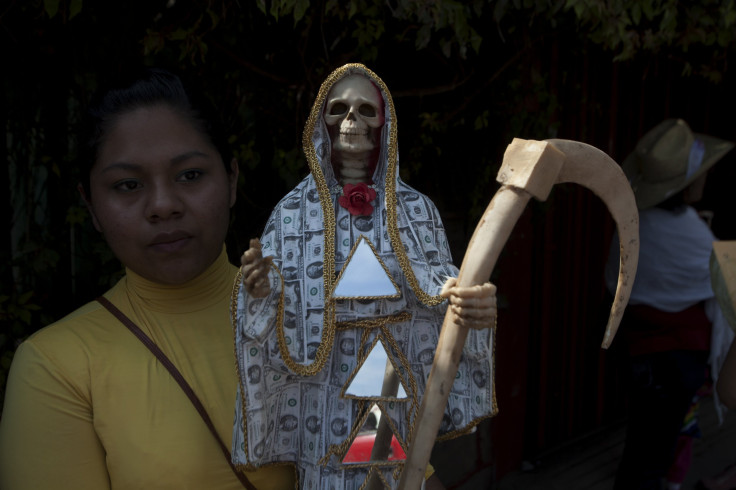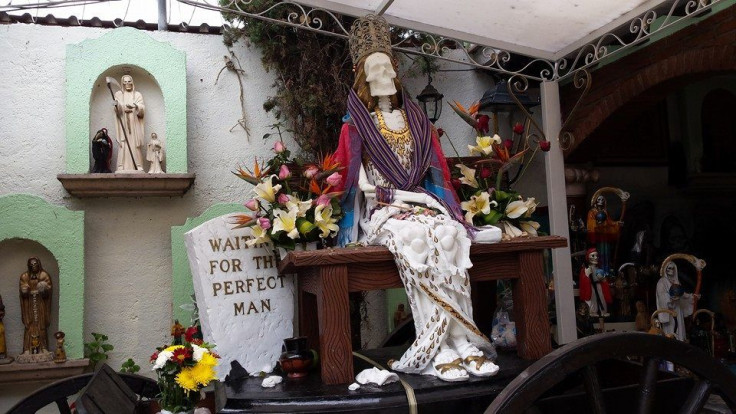Day Of The Dead 2015: Santa Muerte Worshippers Prepare Festivities To Celebrate Mexican Folk Saint

She’s not exactly what you picture when you imagine a venerated saint: a female skeletal figure, clad in long robes, wielding a scythe in her bony hands and bearing only a skull for a head. Then again, this Mexican folk saint is known as Santa Muerte, Spanish for “saint death” or “holy death.” And there are millions of people dedicated to worshipping her, in Mexico and Central America, but also all over the United States.
“It’s a new religious movement -- and the fastest-growing in the Americas,” said Andrew Chesnut, professor of religious studies at Virginia Commonwealth University and author of “Devoted to Death: Santa Muerte, the Skeleton Saint.”
While no hard numbers are available, Chesnut, the world’s leading scholar on the folk saint and her devotees, estimates that there are 10 million to 12 million followers of Santa Muerte in Mexico, Central America and the U.S. That number has exploded since 2001, when a Santa Muerte temple leader in Mexico City named Enriqueta Romero created a public shrine featuring a life-size effigy of the folk saint.
“[Romero] made it more acceptable,” said Chesnut, who added that before Romero’s shrine, most devotees of Santa Muerte kept their veneration behind closed doors. “But the really important motor that propels her growth is that she’s developed a reputation as the speediest and most efficacious miracle worker, mostly in areas related to health, wealth and love.”
Death As A Celebration Of Life
That may be an odd rep for a figure who is believed to represent death itself, but experts say that part of her appeal is her association with safe passage to the afterlife for her devotees. And because Santa Muerte is so closely associated with death, she has increasingly become part of Day of the Dead celebrations, a Mexican holiday celebrated on Nov. 1 and 2 to commemorate the passing of lost loved ones.

“Santa Muerte doesn’t have an annual feast day, but in the last two or three years, increasingly, Santa Muerte practitioners have been incorporating her into their Day of the Dead. It’s almost becoming a de facto feast day for Santa Muerte,” said Chesnut.
Worshippers commemorate the Days of the Dead with food, drinks, music, prayer services and more. Now, parades, effigies and votives featuring Santa Muerte are common in the festivities as well.
The origin of Santa Muerte dates back to when the Spanish colonized the lands now known as Mexico. The Spanish Catholics brought with them images of the Grim Reaper -- which resonated with the indigenous people who also worshiped gods who personified death. The local population incorporated the two ideas to form their own saint. But veneration of Santa Muerte was mostly hidden, until the 20th century when researchers began documenting the veneration beginning in the 1940s.
Since then, Santa Muerte began to be associated with criminals and even the drug trade -- an association Chesnut says exists but has been exaggerated. The saint is popular with working-class people all over Mexico, and that popularity has spread to the United States via immigrants but also interest in the saint who is known to favor society’s discriminated, including gays, lesbians and the poor.
And while most devotees also consider themselves, at least nominally, Catholics, the Roman Catholic church has condemned the worship of Santa Muerte as blasphemous.
"It's not religion just because it's dressed up like religion; it's a blasphemy against religion," Cardinal Gianfranco Ravasi, president of the Vatican's Pontifical Council for Culture, told National Geographic in 2013.
That’s not enough to keep her devotees from worshipping at the feet of Santa Muerte -- possibly because she offers hope and acceptance. “She is a saint who never discriminates,” said Chesnut. “She accepts all comers.”
© Copyright IBTimes 2024. All rights reserved.





















